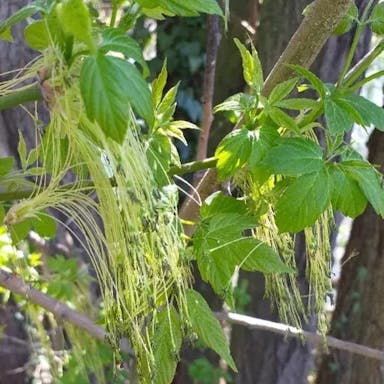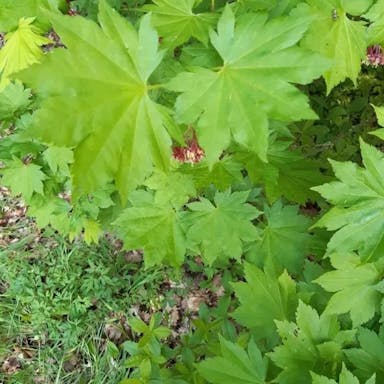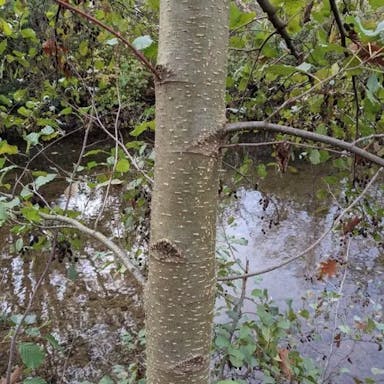Kurrajong plants thrive in full sun to partial shade, requiring at least 6 hours of direct sunlight daily. They exhibit moderate cold tolerance, able to withstand temperatures as low as 20°F (-6°C). In contrast, they have a high heat tolerance, thriving in temperatures up to 100°F (38°C). During summer, ensure adequate watering to prevent dehydration. In winter, reduce watering to avoid waterlogging. Kurrajongs should be placed in well-draining soil to prevent root rot. They benefit from a balanced fertilizer during the growing season. Optimum temperatures range between 65-85°F (18-29°C). Kurrajongs are best suited for outdoor cultivation due to their need for sunlight. Aim for 6-8 hours of sunlight per day for optimal growth.
Kurrajong
- Scientific name
- Brachychiton populneus
Basic Information
- Malvaceae Family Brachychiton Genus Kurrajong Species
- Malvaceae > Brachychiton > Brachychiton populneus
- 83%
- The Completeness of This Encyclopedia
Please help us complete the encyclopedia, Terrarium is a encyclopedia service to be completed with everyone in the world. Currently, this page is 83% complete. For more information on how to contribute, please click here.
- Broad-leaved tree
- Tree
- Height
- 1800cm ~
- Flower Color
- Leaf Color
- Anthesis
- spring, summer
- Sunlight Exposure
Full Sun Long hours of sunlight from morning to afternoon Partial Shade A location in the shade of a tree or where either the morning or afternoon is shaded Full Shade A place where there is no direct sunlight
- Full Sun
- Hardiness Zones
This is an indicator to know to which zone each plant can winter. Knowing the zone of each plant gives you an idea of the cold temperature resistance when grown in the ground without a roof. 2: -42.7 to -40.0 3: -39.9 to -34.4 4: -34.3 to -28.9 5: -28.8 to -23.3 6: -23.2 to -17.8 7: -17.7 to -12.2 8: -12.1 to -6.7 9: -6.6 to -1.1 10: -1.0 to 4.4 11: 4.5 to 10.0
- 9
- Cold resistance
- Fair
- Heat resistance
- Excellent
- Habitat of origin
- Australia
- Growth Rate
- Fast
What is Kurrajong (Brachychiton populneus)?
What is Kurrajong (Brachychiton populneus)
Flower meaning
Kurrajong thrives in well-drained soils with a pH level between 6.0 and 7.5. It benefits from a balanced fertilizer with an N-P-K ratio of 10-10-10 or similar. Fertilizer should be applied in early spring before new growth begins and again in late spring or early summer. Apply fertilizer at a rate of 1 pound per 100 square feet of soil. Avoid over-fertilizing as it can lead to excessive foliage growth at the expense of flowering. Regularly check soil quality to ensure proper drainage and aeration for optimal Kurrajong growth.
Calendar of Kurrajong (Brachychiton populneus)
Calendar
The flower language commonly used in America for the Kurrajong plant is: - Kurrajong: Protection, Strength, Resilience - Kurrajong: Endurance, Perseverance, Survival Example: Kurrajong symbolizes protection and strength. It signifies the ability to withstand challenges and adversity, representing resilience in difficult situations.
How to grow Kurrajong (Brachychiton populneus)
Watering
Kurrajong plants benefit from regular pruning to maintain their shape, promote new growth, and improve overall health. Pruning is typically done in late winter or early spring before new growth emerges. To prune, remove dead or damaged branches, as well as any crossing or crowded branches to allow for better air circulation. After pruning, apply a balanced fertilizer to encourage healthy regrowth. Avoid over-pruning as it can stress the plant.
Soil and Fertilizer
Kurrajong can be propagated through seeds, cuttings, and division. Seeds should be sown in well-draining soil, kept moist, and placed in a warm, sunny location. Cuttings can be taken from mature stems, treated with rooting hormone, and planted in a soil mix. Division involves separating the plant into smaller sections with roots attached and replanting them in individual containers. To maximize propagation success, it is recommended to use a combination of methods. Harvest seeds when they are mature and dry, and take cuttings in the spring or early summer for best results.
Sunlight and Place
Kurrajong is best potted in well-draining soil with a mix of sand and compost. Ensure the pot has drainage holes to prevent waterlogging, which can lead to root rot. When planting, gently loosen the roots and place the plant at the same depth as it was in the nursery container. Water thoroughly after planting and keep the soil consistently moist but not waterlogged. Repot Kurrajong every 2-3 years in a slightly larger pot to accommodate growth. Prune any dead or damaged roots during repotting to encourage healthy growth. If mishowing occurs, check for pests like aphids or spider mites and treat accordingly. Avoid over-fertilizing, as Kurrajong prefers nutrient-poor soil.
Advanced Information of Kurrajong (Brachychiton populneus)
Pruning
Kurrajong is susceptible to various pests and diseases, including scale insects, caterpillars, and powdery mildew. Scale insects can cause damage by sucking sap from the plant, leading to wilting and stunted growth. Caterpillars feed on the leaves, causing defoliation and weakening the plant's overall health. Powdery mildew is a fungal disease that appears as a white powdery substance on the leaves, affecting photosynthesis and nutrient absorption. To prevent these issues, regular inspection of the plant for signs of pests or diseases is crucial. Implementing proper cultural practices such as adequate spacing between plants, proper watering, and ensuring good air circulation can help reduce the risk of infestations. In severe cases, chemical treatments may be necessary, but it is essential to follow instructions carefully to avoid harming the plant or the environment. Regular pruning of affected areas can also help manage pest and disease populations.
Planting and Harvest
Kurrajong in the United States typically blooms in late spring to early summer. The flowers are at their best during the month of June. Blooming usually occurs once a year, lasting for about 2-3 weeks. To extend the blooming period, ensure the plant receives adequate sunlight, water, and nutrients. Pruning after flowering can also promote more blooms the following year. Maintaining consistent care throughout the growing season can help prolong the flowering period. Adequate fertilization and soil moisture are essential for healthy flower production. Avoid overwatering or underwatering, as this can affect blooming. In colder regions, consider planting Kurrajong in a sheltered spot to protect it from harsh winter conditions.
Propagation
Kurrajong seedlings should have well-developed roots and sturdy stems. Look for seeds that are plump and free of mold. For Kurrajong varieties like "Bottle Tree," ensure the seedlings have a thick trunk. "Lacebark" varieties should have delicate, lacy foliage. "Queensland Lacebark" is known for its pink flowers. "Kapok" varieties should have a straight trunk and large, glossy leaves. Check for any signs of disease or pests before purchasing. Always choose healthy and vigorous seedlings for successful growth.
Pests and Diseases
Kurrajong, scientifically known as Brachychiton populneus, is a deciduous tree native to Australia. It belongs to the Malvaceae family and is characterized by its distinctive bell-shaped flowers that range in color from pink to red. The leaves are glossy green, resembling those of a poplar tree, hence the species name "populneus." The tree can grow up to 15 meters in height and is known for its drought tolerance and adaptability to various soil types. Brachychiton populneus is commonly planted as an ornamental tree in gardens and parks due to its attractive appearance and minimal maintenance requirements. It produces woody fruit capsules that contain seeds which are dispersed by wind. There are several cultivated varieties of Brachychiton populneus, each with slight variations in flower color and growth habit. Overall, this tree is prized for its ornamental value and ease of cultivation in a wide range of climates.
Habitat of Kurrajong (Brachychiton populneus)
Habitat
Toxicity of Kurrajong (Brachychiton populneus)
Health Benefits
- edible
- Inedible
- Toxic
- No toxicity
NO DATA
Toxic for dogs and cats
NO DATA












